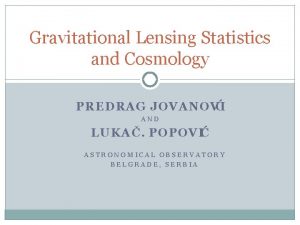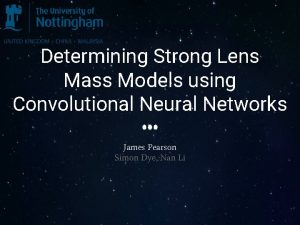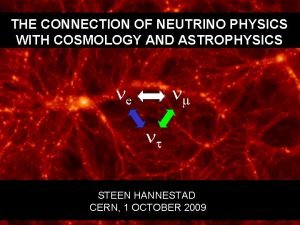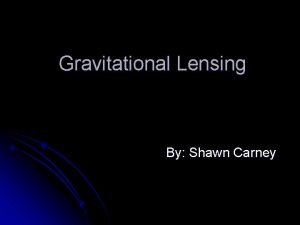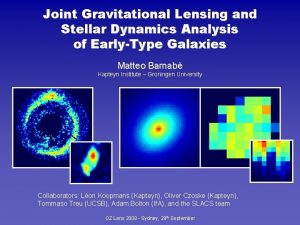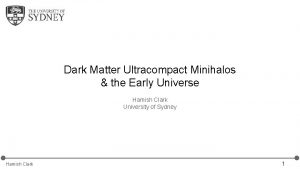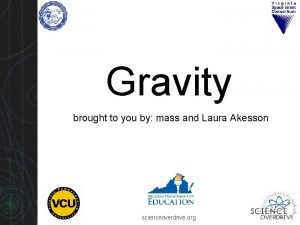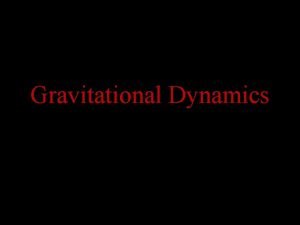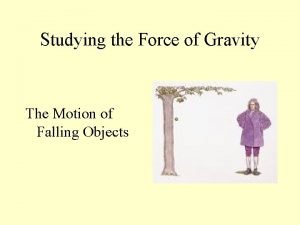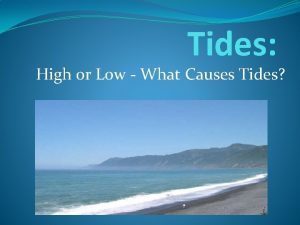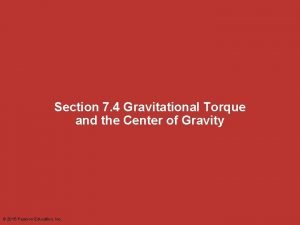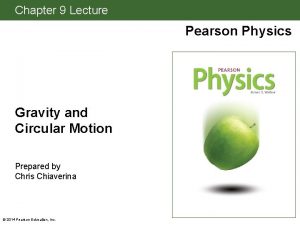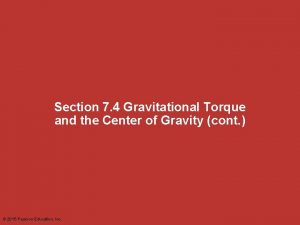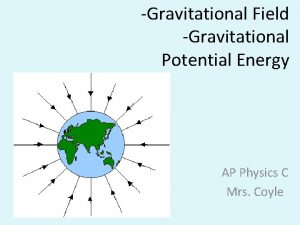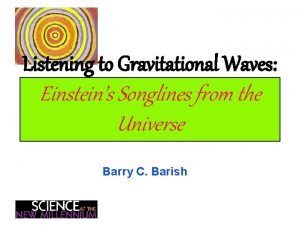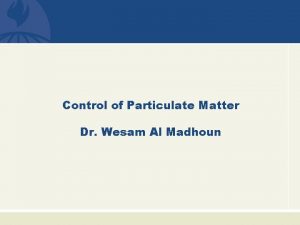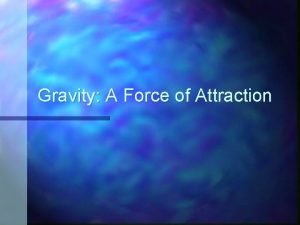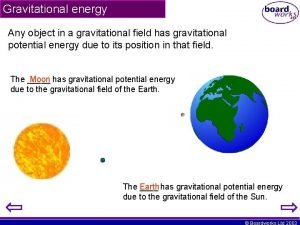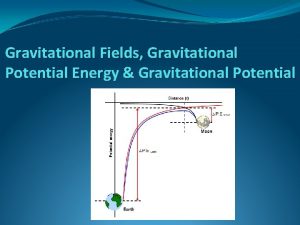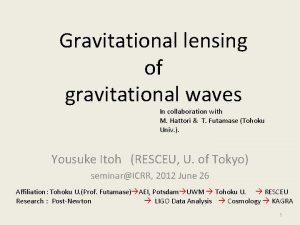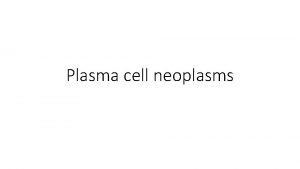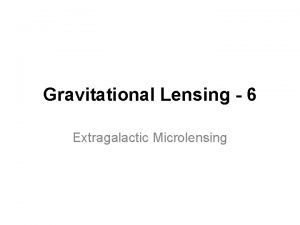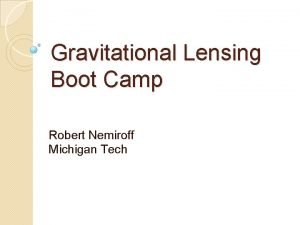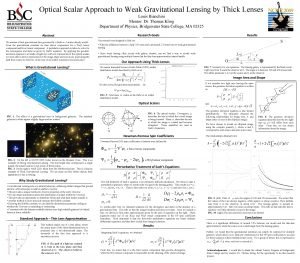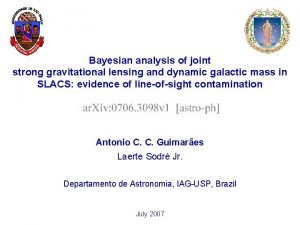Gravitational lensing in plasma O Yu Tsupko 1

















- Slides: 17

Gravitational lensing in plasma O. Yu. Tsupko 1, 2 and G. S. Bisnovatyi-Kogan 1, 2 1 Space Research Institute of Russian Academy of Science, Profsoyuznaya 84/32, Moscow 117997 2 Moscow Engineering Physics Institute, Moscow, Russia e-mail: gkogan@iki. rssi. ru, tsupko@iki. rssi. ru

Einstein’s deflection law vacuum General Relativity predicts that a light ray which passes by a spherical body of mass M with impact parameter b, is deflected by the “Einstein angle”: provided the impact parameter b is much larger then the corresponding Schwarzschild radius R_S: In the most astrophysical situations related with gravitational lensing approximation of weak deflection is well satisfied. This angle does not depend on frequency of the photon

The simplest model of the Schwarzschild point-mass lens On basis of Einstein deflection angle ordinary GL theory is developed. At this picture there is the example of the simplest model of Schwarzschild pointmass lens which gives two images of source instead of one single real source.

Vacuum -> plasma It is well known that in inhomogeneous medium photons moves along curved trajectory, and if medium is dispersive the trajectory depends on frequency of the photon. In plasma: Vphase = c/n, Vgroup = cn, Vphase Vgroup = c 2

Gravitational lensing in plasma, previous results D. O. Muhleman and I. D. Johnston, 1966; D. O. Muhleman, R. D. Ekers, and E. B. Fomalont, 1970. A. P. Lightman, W. H. Press, R. H. Price, S. A. Teukolsky, Problem Book in Relativity and Gravitation, 1979. P. V. Bliokh and A. A. Minakov, Gravitational Lenses (Naukova Dumka, Kiev, 1989), in Russian. In previous papers of different authors concerning deflection of light by both gravitation and plasma there was separated consideration of two effects: Gravitational deflection of light in vacuum It does not depend on frequency + Deflection of light in non-homogeneous medium It depends on frequency if the medium is (non-relativistic effect) dispersive, but is equal to zero if the medium is homogeneous

The new result: In this work we show that due to dispersive properties of plasma even in the homogeneous plasma gravitational deflection will differ from vacuum deflection angle, and gravitational deflection angle in plasma will depend on frequency of the photon. Self-consistent approach for geometrical optics in curved space-time in medium: J. L. Synge, Relativity: the General Theory, North-Holland Publishing Company, Amsterdam, 1960. On basis of his general approach we developed the model of gravitational lensing in plasma.


We derive the deflection angle for the photon moving in a weak gravitational field in the arbitrary inhomogeneous plasma. We consider here only the situation, when the whole deflection angle, from the combined plasma and gravity effects, remains small. If the problem is axially symmetric, it is convenient to introduce the impact parameter b, and we obtain for the deflection angle of the photon moving along z-axis


Gravitational radiospectrometer When gravitating body is surrounded by a plasma, the lensing angle depends on a frequency of the electromagnetic wave due to refraction properties, and the dispersion properties of the light propagation in plasma. The last effect leads to dependence, even in the homogeneous plasma, of the lensing angle on the frequency, what resembles the properties of the refractive prism spectrometer. The strongest action of this spectrometer is for the frequencies slightly exceeding the plasma frequency, what corresponds to very long radiowaves. in vacuum in homogeneous plasma may be much larger!

GRAVITATIONAL RADIOSPECTROMETER λ 1 < λ 2 < λ 3 vgr 1 > vgr 2 > vgr 3 Instead of two concentrated images with complicated spectra, we will have two line images, formed by the photons with different frequencies, which are deflected by different angles. α 1 < α 2 < α 3

Observations The typical angular separation between images of the source depends on deflection law. A difference between the angular separation of similar images in vacuum and in plasma is defined as This formula gives the difference between the deviation angle of the radio wave with the frequency , and the optical image, which may be described by the vacuum formula.

Observations at Radio. Astron http: //www. radioastron. ru/ Let us estimate possibility of the observation of this effect by the planned project Radioastron. The Radioastron is the VLBI space project led by the Astro Space Center of Lebedev Physical Institute in Moscow. The payload is the Space Radio Telescope, based on the spacecraft Spektr-R. Frequency band (GHz) : 0. 327 (P); 1. 665 (L); 4. 830 (C); 18. 392 -25. 112 (K) The observed angular separation of quasar images is usually around 1 arcsec. ωe 2/ω2 10 -4

Magnification of the image depends on the lensing angle, therefore different images may have different spectra in the radio band, when the light propagates in regions with different plasma density.

Comparition with other works Kulsrud, Loeb, 1992, Ph. Rv. D. . 45. . 525 K Broderick, Blandford, 2003 Ap&SS. 288. . 161 B Broderick, Blandford, 2003 MNRAS. 342. 1280 B The photon moves in gravitational field and in homogeneous plasma exactly like a massive particle with the following parameters


Conclusions Gravitational lens in plasma acts as a gravitational radiospectrometer Expectations for the observations: 1) Extended image may have different spectra along the image 2) Spectra of point source images may be different in the long wave side Bisnovatyi-Kogan G. S. , Tsupko O. Yu. Gravitational radiospectrometer // Gravitation and Cosmology. 2009. V. 15. N. 1. P. 20. ar. Xiv: 0809. 1021 v 2 [astro-ph] 19 Sep 2008
 Einstein cross
Einstein cross Gravitational lensing
Gravitational lensing Weak lensing
Weak lensing Einstein cross
Einstein cross Lensing
Lensing Lensing
Lensing Gravitational mass vs inertial mass
Gravitational mass vs inertial mass Gravitational poisson equation
Gravitational poisson equation Friction and gravity
Friction and gravity What is the tidal bulge
What is the tidal bulge Gravitational torque equation
Gravitational torque equation Applications of gravitational force
Applications of gravitational force Gravitational torque equation
Gravitational torque equation Gravitational potential energy
Gravitational potential energy Giant gravitational wave detectors hear murmurs
Giant gravitational wave detectors hear murmurs Gravitational settling chamber
Gravitational settling chamber What is the effect of gravitational force
What is the effect of gravitational force Gravitational potential energy
Gravitational potential energy
